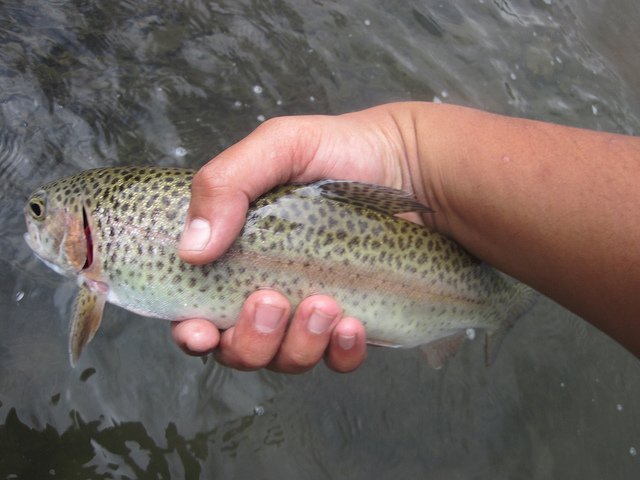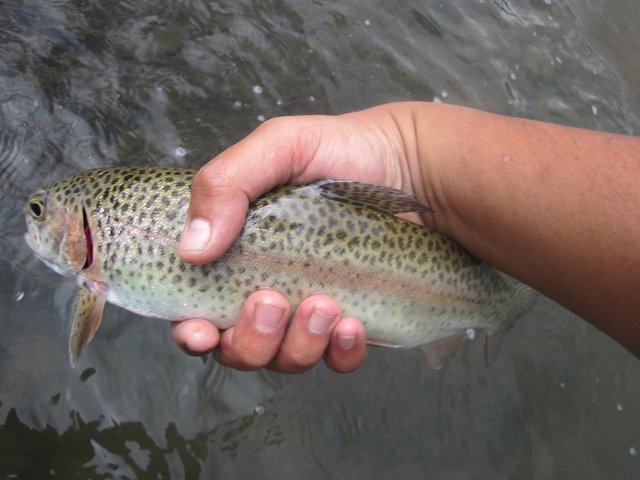
A stream is like a sandwich. If you remember that one simple fact when fishing nymphs, you will take an important step toward catching more fish. Although it seems a bit simplistic, the comparison is a helpful reminder that a stream consists of four layers, and that your nymph needs to drift within a specific layer to have its best shot at enticing a fish to bite.
Any type of fly-fishing requires the ability to read the stream by scanning its surface. Most anglers look first for insect and fish activity; then they dissect the stream’s structure for holding areas like eddies, riffles, seams, and pools. But nymph angling requires another dimension to the read that involves understanding what is happening below the surface.
Since underwater activity is often not visible, you need to start with a given set of rules concerning the stream’s flow and trout activity; then collect clues that will provide a clearer picture of what nymphing techniques will take fish under those conditions.
First, you must understand the stream’s flow. Imagine a cross section of the stream, like that sandwich mentioned earlier. Within that sandwich, there are four layers of water. The bottom layer rides right along the streambed. It is the slowest of the four layers,
because of the friction created as the water runs over the bed material. The second layer is the largest and fastest of the four. The third layer is the surface, which runs a bit slower than the second layer. Lastly there is the surface film, also called the meniscus, which is created by the water’s contact with the air.
For nymph anglers, the second layer is the most important, because it carries the flow of sub-surface food and it is the layer where trout spend the majority of their feeding time. With this information in hand, you can begin using it as a foundation on which to build your approach to fishing a given stream section.
The first step is to look for fish activity. If you do not see any rises or swirls, it is a good bet the fish that are feeding are taking nymphs near the bottom of the that second layer. If you see swirls just below the surface; then the fish are feeding higher in that second layer, possibly on emergers. Visible fish and insect activity on the surface reveals that fish are feeding in the meniscus, but it is important to note that even if there is a major hatch occurring and fish are rising all around you, there still will be fish in that second layer, feeding on nymphs.
The second step is figuring out what types of nymphs are present in that second layer. Tradition says to start turning over rocks in search of nymphs, but that only tells you what is clinging to the rocks in the first layer; it does not tell you what types of nymphs are drifting through the second layer. The most reliable strategy is to use a seine. A few quick samplings will tell you exactly what types of nymphs are drifting past the trout.
The next step is selecting a nymph pattern that matches those sampled in the second
layer. My philosophy is to keep nymph selection simple. I carry about 10 basic patterns tied in a variety of sizes and weights, but throughout the year there are three patterns that I depend on heavily. They include the pheasant tail, hare’s ear, and prince.
The most important aspects to selecting a nymph pattern are size and shape. Trout see little more than a silhouette of the nymph, so your pattern need only reasonably match the shape and size of the nymphs in your seine. Color does play a role at times, but in most cases, only as it relates to shades of light and dark. More important than color is translucency, or the softness of the nymph’s form. Neatly tied nymphs are often the least effective, because they lack translucency. I add softness to the form of a nymph by ratting and teasing the materials after it is tied.
With a pattern selected, you must next decide how much weight is needed to keep your nymph within the feeding zone of that second layer. The crucial mistake many anglers make is using a one-size-fits-all approach to weighting their nymphs. They tie all their nymphs with the same amount of weight and do not take into consideration that certain stream structure requires a specific amount of weight to keep the nymph where the fish are feeding. For example, if you are fishing the head of a large pool with a significant flow of whitewater rushing into it, and you want your nymph to reach the bottom of the second layer, you will need more weight. A tungsten head is ideal for fast, heavy flows, because it gets the nymph down quickly and keeps it down. Conversely, a slow moving pool requires little if any weight to keep the nymph drifting naturally within the bottom of the second layer.
In many cases, picking the right weight takes some experimenting. If your nymph is continually snagging the bottom; then it is riding in the first layer and is too heavy. If fish are feeding in the upper portion of the second layer, start with an unweighted nymph and add weight until you reach the level where the fish are feeding. Sometimes the nymphs are actually drifting within the third or fourth layers and a floating nymph is required.
To make certain you are prepared to fish a variety of stream structure, tie you nymphs in at least three different weights. I usually tie mine with 3/32 and 1/8 bead heads, and with no weight at all. I also tie lead-bodied versions in two different weights for variety. In addition, I tie soft-hackle versions of each nymph in weighted and unweighted varieties. The soft-hackle patterns are especially effective when the trout are feeding in the upper portion of the second layer.
A common practice among nymph anglers is to weight a nymph by adding split shot to the line. My preference is to avoid this technique, because often times the split shot rides along the bottom in that slower first layer, while the nymph is drifting in the faster second layer. I have to believe this has a detrimental effect on the natural drift of the nymph, but it may just be a matter of personal taste.
Whatever technique you use, the key to fishing nymphs is experimenting with patterns and weights until you find combinations that work. With more experience you will gain a greater understanding of what is happening below the surface and how to read and approach the most important layer of a trout stream.
Photo credit: Flickr Creative Commons








